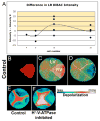Early, H+-V-ATPase-dependent proton flux is necessary for consistent left-right patterning of non-mammalian vertebrates
- PMID: 16554361
- PMCID: PMC3136117
- DOI: 10.1242/dev.02341
Early, H+-V-ATPase-dependent proton flux is necessary for consistent left-right patterning of non-mammalian vertebrates
Abstract
Biased left-right asymmetry is a fascinating and medically important phenomenon. We provide molecular genetic and physiological characterization of a novel, conserved, early, biophysical event that is crucial for correct asymmetry: H+ flux. A pharmacological screen implicated the H+-pump H+-V-ATPase in Xenopus asymmetry, where it acts upstream of early asymmetric markers. Immunohistochemistry revealed an actin-dependent asymmetry of H+-V-ATPase subunits during the first three cleavages. H+-flux across plasma membranes is also asymmetric at the four- and eight-cell stages, and this asymmetry requires H+-V-ATPase activity. Abolishing the asymmetry in H+ flux, using a dominant-negative subunit of the H+-V-ATPase or an ectopic H+ pump, randomized embryonic situs without causing any other defects. To understand the mechanism of action of H+-V-ATPase, we isolated its two physiological functions, cytoplasmic pH and membrane voltage (Vmem) regulation. Varying either pH or Vmem, independently of direct manipulation of H+-V-ATPase, caused disruptions of normal asymmetry, suggesting roles for both functions. V-ATPase inhibition also abolished the normal early localization of serotonin, functionally linking these two early asymmetry pathways. The involvement of H+-V-ATPase in asymmetry is conserved to chick and zebrafish. Inhibition of the H+-V-ATPase induces heterotaxia in both species; in chick, H+-V-ATPase activity is upstream of Shh; in fish, it is upstream of Kupffer's vesicle and Spaw expression. Our data implicate H+-V-ATPase activity in patterning the LR axis of vertebrates and reveal mechanisms upstream and downstream of its activity. We propose a pH- and Vmem-dependent model of the early physiology of LR patterning.
Figures









References
-
- Adams D, Levin M. Gap junctions and ion fluxes in patterning: strategies for investigating biophysical epigenetic control mechanisms in Xenopus. In: Whitman M, Sater AK, editors. Analysis of Growth Factor Signaling in Embryos. Boca Raton, FL: Taylor & Francis; 2006. in press.
-
- Albertson RC, Yelick PC. Roles for Fgf8 signaling in left-right patterning of the visceral organs and craniofacial skeleton. Dev Biol. 2005;283:310–321. - PubMed
-
- Akopian AN, Chen CC, Ding Y, Cesare P, Wood JN. A new member of the acid-sensing ion channel family. NeuroReport. 2000;11:2217–2222. - PubMed
-
- Al-Awqati Q. Plasticity in epithelial polarity of renal intercalated cells: targeting of the H(+)-ATPase and band 3. Am J Physiol. 1996;270:C1571–C1580. - PubMed
-
- Amack JD, Yost HJ. The T box transcription factor no tail in ciliated cells controls zebrafish left-right asymmetry. Curr Biol. 2004;14:685–690. - PubMed
Publication types
MeSH terms
Substances
Grants and funding
LinkOut - more resources
Full Text Sources
Other Literature Sources
Molecular Biology Databases

